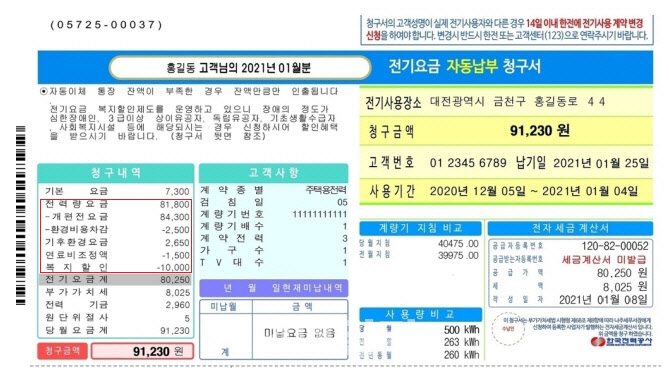The climate environment charge, which was included in the price so far, but was not known to consumers, is also notified separately. A four-person household that uses 350kWh per month is expected to pay less electricity by 945 won.
|
Looking at the changed items, the’Fuel Cost Adjustment’ reflects the fuel cost related to electricity production, such as liquefied natural gas (LNG), coal, and oil, in the rate every three months. The fuel cost adjustment fee is calculated as the difference between the actual fuel cost (average fuel cost for the previous three months) and the standard fuel cost (average fuel cost for the previous year). The earnings fuel cost on the January bill should be calculated from September to November last year, and the standard fuel cost from December 2019 to November last year.
However, since it is the first implementation, the bills received from the 11th have been adjusted for fuel costs from January to March this year, and have been set at -3.0 won per kWh according to the trend of falling oil prices. For households that use 350kWh per month, the fuel cost adjustment unit is -1050 won. The difference is that you can check the specific amount in the fuel cost adjustment fee section of the bill.
‘Environmental costs’ are expenses expended by power generation companies to reduce the impact of environmental pollution, including the cost of fulfilling the obligations of new and renewable energy (RPS), the cost of trading greenhouse gas emissions (ETS), and the cost of reducing coal power generation due to the implementation of the seasonal fine dust management system. .
The environmental cost unit price to be applied this month is 4.5 won per kWh for RPS and 0.5 won for ETS. This includes 0.3 won per kWh, which is the cost of reducing coal power generation, which is actually 5.3 won per kWh. 5.0 won is the price that has been reflected in the rate so far, and only 0.3 won for the reduction of coal power generation has increased.
The’climate environment charge’ costs 5.3 won per kWh, so 1855 won per 350 kWh is stamped on the bill. However, 5.0 won per kWh is the price that was previously charged, so if you calculate the newly increased 0.3 won, 105 won per 350 kWh is a net increase in climate and environment costs.
|
Depending on the fuel cost linkage, the rate may rise or fall up to 5 won per kWh per year, but instead, the fluctuation range is limited on a quarterly basis. It is a structure that the fuel cost adjustment amount cannot be increased rapidly. In addition, if there is an exceptional situation in which oil prices rise sharply within a short period of time, the government may delay rate adjustment. An official from KEPCO explained, “To prevent sudden fluctuations, the range of changes compared to the previous rate is limited to 3 won, and changes within 1 won per kWh are not reflected.”
For a four-person household that uses 350kWh per month, the actual discounted electricity rate is 945 won when the fuel cost adjustment unit price is -1050 won and the net increase in climate and environment costs is 105 won.
|
Based on 350kWh of electricity used for residential use, the actual billing amount is lowered from 50,080 won to 54,135 when the electricity bill is added to VAT and the power fund. According to the Ministry of Trade, Industry and Energy’s plan, it is expected to pay 700 won per 350 kWh less in the second quarter than the current one.
From July, even at home, you can choose a timed rate plan that varies depending on the season and time. It allows you to choose a low-cost rate plan according to your own electricity consumption patterns that differ according to the season and time of day. However, the hourly rate plan will be implemented step-by-step from the Jeju area where the supply of smart meters (AMI) that can measure the amount of usage by time slot has been completed.
|




